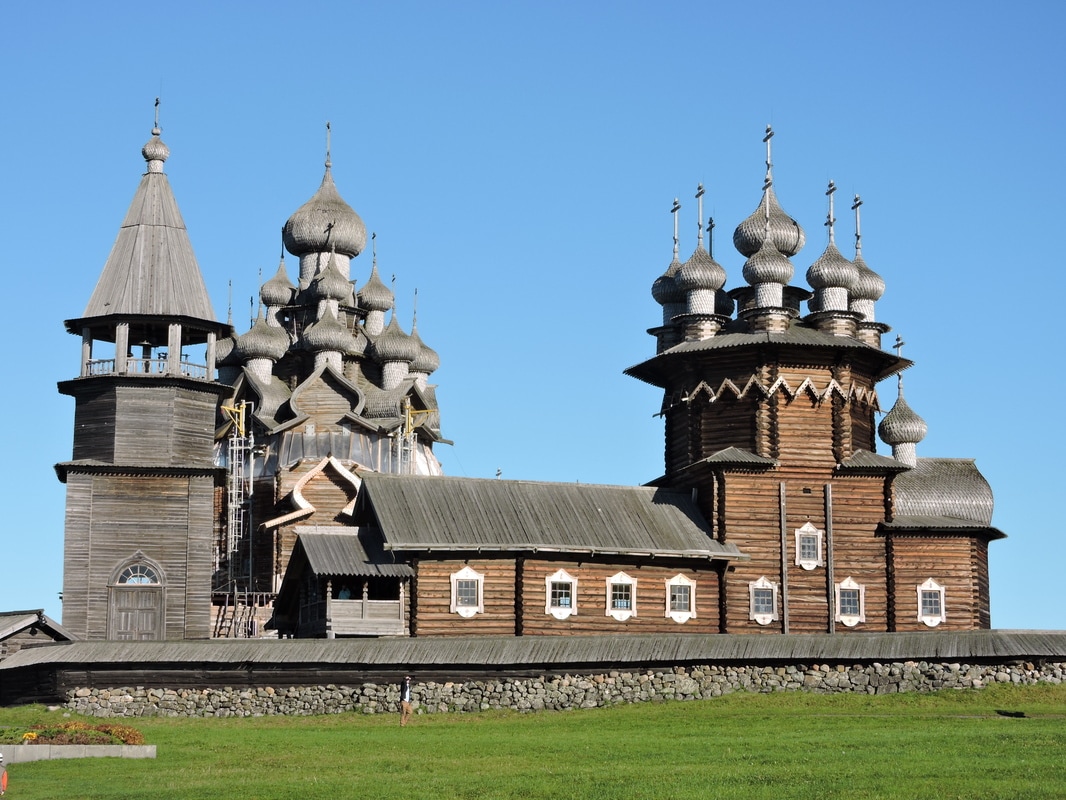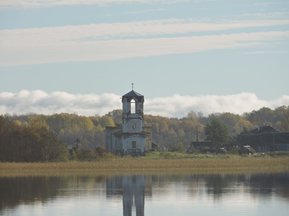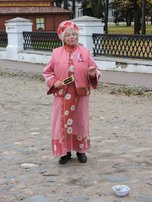

| That night our ship entered Lake Onega, Europe’s second largest lake, near the Arctic Circle, and the northernmost point of our journey. Our destination was Kizhi Island, in the middle of the lake. Dawn was glorious with herringbone cloud patterns in the sky, reflected in the glossy water. But quickly the fog rolled in and our outing to see Kizhi Island’s two Fifteenth Century wooden churches was postponed, as Russian law prevents riverboats from proceeding during fog. In midmorning the fog lifted, and in gorgeous but freezing sunlight we docked at tiny Kizhi for a walking tour along wooden sidewalks to the two beautiful churches. The larger church has twenty-two stunning onion domes, all constructed only of wood and roofed with aspen shingles which glittered like gold in the sunlight. Wooden pegs were used in the construction, but not a single metal nail. |
The larger of the two churches is unheated and is used in summer. The smaller nine-domed church contains a wood stove for winter heating. The churches are made of unpainted horizontal pine logs and share a single plot of land which includes a graveyard filled with Russian style wood crosses. The churches and the cemetery are enclosed by a low stone wall topped by more horizontal pine logs and aspen shingles to keep the cattle and other animals out of the sacred space.
| The Church of Elijah the Prophet is also an architectural and artistic gem. Built of brick in 1650, the church has five beautiful bluish green onion domes, a bell tower, and world-famous egg-tempera frescoes in its lush interior. We were fascinated by the painting of Elijah the Prophet at the mouth of his cave, being fed by ravens. Other paintings in the church depict domestic scenes, and the everyday activities of peasants, including harvests, weddings, hunting and animals. |
| While in Yaroslavl, we also visited a lively farmers market, filled with the foods enjoyed every day by Russian families, dark bread, potatoes, cabbages, carrots, onions, the ubiquitous beets, lots of meats and piles of dried fruits. In addition, we had the pleasure of visiting the former Governor’s Mansion, now a museum, where we were treated to a chamber music trio who played classical pieces and a group of young people in period costumes who danced the polonaise, polkas and waltzes, accompanied by the accomplished musicians. |

Borscht with Pelmeni Garnished with Sour Cream and Dill
(Recipes below)
Charlotte’s Marinated Mushrooms
(A Russian Tea, myteaplanner.com)
Open-faced Smoked Salmon Sandwiches on Swirled Rye
(A Russian Tea, myteaplanner.com)
Charlotte Rousse
(A Russian Tea, myteaplanner.com)
Suzi’s Marbled Sugar Cookie Hearts
(Kathleen’s Blog: February 2017, “Valentine’s Day”
Russian Caravan Tea and or Vodka
- 2-3 medium sized beets, greens removed and peeled
- 1 large onion
- 2 medium sized russet potatoes
- 1 small head of cabbage
- 1 large carrot
- 4 tablespoons butter (or use olive oil, but the flavor will not be as good)
- 2 cloves of garlic
- 1 slice of lemon, peel cut off
- salt and pepper
- 1 bay leaf
- 1 large can (49.5 ounces) chicken broth
- sour cream for garnish
- chopped sprigs of fresh dill for garnish
Special equipment: large sharp knife, wooden spoon or heat-proof rubber spatula, food grater, large Dutch oven or other cooking pot with lid, ladle
Makes: 6-8 servings
- Thinly slice the onion, beets and potatoes; then cut them into small julienned pieces. Melt the butter in a large Dutch oven or cooking pot over medium low heat, and add the cut-up vegetables, stirring with a wooden spoon or rubber spatula until the onions start to turn golden.
- As the vegetables continue to cook, grate the carrot and the cabbage and add them to the pot, stirring to make sure the vegetables do not stick to the bottom and burn. Add a little of the chicken broth if the mixture becomes too dry. Saute the vegetable mixture for about 20 minutes.
- Season the vegetables in the pot with salt (about 1 teaspoon) and freshly ground pepper to taste and stir. Add the bay leaf. Finely mince 2 cloves of garlic and stir into the vegetable mixture. Cook briefly. Pour the remaining chicken broth into the pot, and bring the soup to a simmer on medium heat.
- Chop the lemon slice into small pieces and add to the pot. (The purpose of adding lemon is to preserve the bright red color of the beets.) Place the lid on the pot at an angle so steam can escape and simmer on low heat for about half an hour. Taste the soup and adjust the amount of salt and pepper if you wish.
- To serve, ladle the Borscht into bowls, top with a dollop of sour cream, and sprinkle each bowl with a little chopped fresh dill. Add Pelmeni to the Borscht if you wish.
Pelmeni
These little savory dumplings resemble tortellini or won ton and are delicious boiled and served in soups, like the Italian and Chinese versions. This recipe calls for a meat filling of ground beef, ground pork, onions and garlic. You can also make vegetarian Pelmeni by filling the pasta pockets with a mixture of ricotta cheese, black pepper and chopped chives. These Pelmeni will be boiled and added to a pot of hot Borscht for a hearty Russian lunch.
For the Pasta:
- 3 cups flour, plus more for rolling out the pasta
- 2 large eggs
- ¾ cup water
- ¼ teaspoon salt
For the Filling:
- ½ pound ground beef
- ½ pound ground pork
- 1 onion, finely chopped
- 5 garlic cloves, finely chopped
- ½ teaspoon salt
- ½ teaspoon freshly ground black pepper
- 2 large egg whites, beaten
Garnish:
- Sour cream or
- Melted butter
- Sprigs of dill
Special equipment: large mixing bowl, fork, rolling pin, ruler, round 2-inch cookie cutter, medium sized mixing bowl, teaspoon, pastry brush, large cooking pot
Makes: 6 servings
- Make the pasta. In a large bowl, combine 2 cups of the flour, 2 eggs, water and salt. Stir with a fork until the flour is moistened and the eggs have been incorporated into the mixture. Knead, adding the remaining flour, until the dough forms a ball.
- Transfer the dough to a floured surface and roll it out until it is very thin, about 1/16”. Using a round 2” cookie cutter, cut the dough into circles. Set aside. Bring a large pot of water to a boil over high heat.
- Make the filling as the water comes to a boil. Combine all of the filling ingredients in a medium sized bowl and mix thoroughly with your hands. Place a teaspoon of the filling in the center of each of the dough circles. Brush the edges with egg white and fold each dumpling in half, pressing the edges to seal.
- Add the Pelmeni to the boiling water and cook for about 5 minutes until the filling is cooked through. Serve alone topped with sour cream and dill or melted butter, or add to a pot of hot Borscht for a hearty soup.














 RSS Feed
RSS Feed